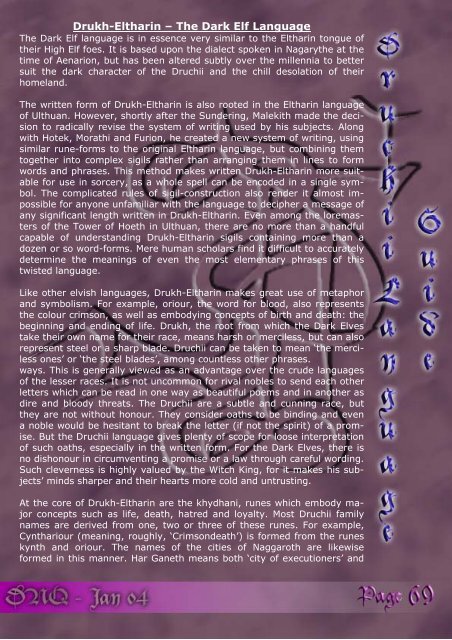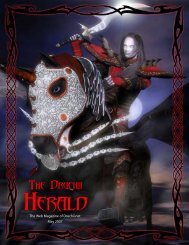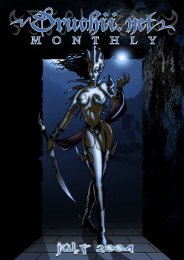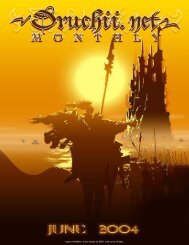You also want an ePaper? Increase the reach of your titles
YUMPU automatically turns print PDFs into web optimized ePapers that Google loves.
Drukh-Eltharin – The Dark Elf Language<br />
The Dark Elf language is in essence very similar to the Eltharin tongue of<br />
their High Elf foes. It is based upon the dialect spoken in Nagarythe at the<br />
time of Aenarion, but has been altered subtly over the millennia to better<br />
suit the dark character of the <strong>Druchii</strong> and the chill desolation of their<br />
homeland.<br />
The written form of Drukh-Eltharin is also rooted in the Eltharin language<br />
of Ulthuan. However, shortly after the Sundering, Malekith made the decision<br />
to radically revise the system of writing used by his subjects. Along<br />
with Hotek, Morathi and Furion, he created a new system of writing, using<br />
similar rune-forms to the original Eltharin language, but combining them<br />
together into complex sigils rather than arranging them in lines to form<br />
words and phrases. This method makes written Drukh-Eltharin more suitable<br />
for use in sorcery, as a whole spell can be encoded in a single symbol.<br />
The complicated rules of sigil-construction also render it almost impossible<br />
for anyone unfamiliar with the language to decipher a message of<br />
any significant length written in Drukh-Eltharin. Even among the loremasters<br />
of the Tower of Hoeth in Ulthuan, there are no more than a handful<br />
capable of understanding Drukh-Eltharin sigils containing more than a<br />
dozen or so word-forms. Mere human scholars find it difficult to accurately<br />
determine the meanings of even the most elementary phrases of this<br />
twisted language.<br />
Like other elvish languages, Drukh-Eltharin makes great use of metaphor<br />
and symbolism. For example, oriour, the word for blood, also represents<br />
the colour crimson, as well as embodying concepts of birth and death: the<br />
beginning and ending of life. Drukh, the root from which the Dark Elves<br />
take their own name for their race, means harsh or merciless, but can also<br />
represent steel or a sharp blade. <strong>Druchii</strong> can be taken to mean ‘the merciless<br />
ones’ or ‘the steel blades’, among countless other phrases.<br />
ways. This is generally viewed as an advantage over the crude languages<br />
of the lesser races. It is not uncommon for rival nobles to send each other<br />
letters which can be read in one way as beautiful poems and in another as<br />
dire and bloody threats. The <strong>Druchii</strong> are a subtle and cunning race, but<br />
they are not without honour. They consider oaths to be binding and even<br />
a noble would be hesitant to break the letter (if not the spirit) of a promise.<br />
But the <strong>Druchii</strong> language gives plenty of scope for loose interpretation<br />
of such oaths, especially in the written form. For the Dark Elves, there is<br />
no dishonour in circumventing a promise or a law through careful wording.<br />
Such cleverness is highly valued by the Witch King, for it makes his subjects’<br />
minds sharper and their hearts more cold and untrusting.<br />
At the core of Drukh-Eltharin are the khydhani, runes which embody major<br />
concepts such as life, death, hatred and loyalty. Most <strong>Druchii</strong> family<br />
names are derived from one, two or three of these runes. For example,<br />
Cynthariour (meaning, roughly, ‘Crimsondeath’) is formed from the runes<br />
kynth and oriour. The names of the cities of Naggaroth are likewise<br />
formed in this manner. Har Ga<strong>net</strong>h means both ‘city of executioners’ and






